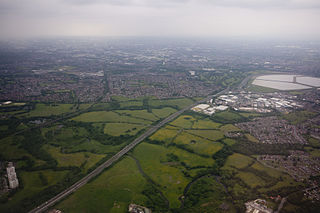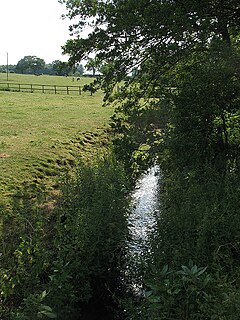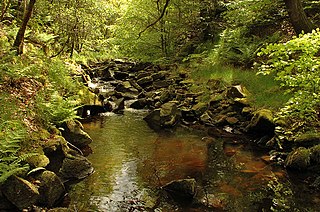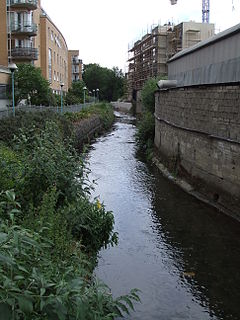This article does not cite any sources .(December 2009) (Learn how and when to remove this template message) |

Newall Green is an area in the Wythenshawe district of Manchester, England. It is on the west side of the M56 motorway, approximately 1 mile from Wythenshawe Town Centre.

Wythenshawe is an area of south Manchester, England.

Manchester is a city and metropolitan borough in Greater Manchester, England, with a population of 545,500 as of 2017. It lies within the United Kingdom's second-most populous built-up area, with a population of 3.2 million. It is fringed by the Cheshire Plain to the south, the Pennines to the north and east, and an arc of towns with which it forms a continuous conurbation. The local authority is Manchester City Council.

England is a country that is part of the United Kingdom. It shares land borders with Wales to the west and Scotland to the north-northwest. The Irish Sea lies west of England and the Celtic Sea lies to the southwest. England is separated from continental Europe by the North Sea to the east and the English Channel to the south. The country covers five-eighths of the island of Great Britain, which lies in the North Atlantic, and includes over 100 smaller islands, such as the Isles of Scilly and the Isle of Wight.
Newall Green has two secondary schools, St Paul's Catholic High School and Newall Green High School and numerous primary schools. St. Paul's High School, the only Catholic secondary school in Wythenshawe, was created from the amalgamation of St. Paul's Secondary Modern, All Hallows High School, St. Columba's Secondary Modern and St. Augustine's Grammar School. It swapped sites with the adjacent St. Peter's Primary School. St. Peter's RC Church stood next to the primary school until demolished in 1998.
St Paul's Catholic High School is a mixed Roman Catholic secondary school located in the Newall Green area of Manchester, England.
Newall Green High School is an Academy in Wythenshawe, Manchester, England. In 2015 Newall Green High School became an Academy as part of the CHS Multi Academy Trust(MAT) - a partnership between Newall Green and Chorlton High schools.

Primary education also called an elementary education is typically the first stage of formal education, coming after preschool and before secondary education. Primary education usually takes place in a primary school or elementary school. In some countries, primary education is followed by middle school, an educational stage which exists in some countries, and takes place between primary school and high school. Primary Education in Australia consists of grades foundation to grade 6. In the United States, primary education is Grades 1 - 3 and elementary education usually consists of grades 1-6.
It was named after Newall Green Farm, whose farmhouse still exists on the west edge of the built-up area of Newall Green.
The area was owned by the Massey family and tithed out to farmers and market gardeners. Rolling Gate farm to the south ( later ?mistranscribed to Roaring Gate farm ), Newall Green Farm, Knob Hall and Mill House and White House farms all fell within the present day Newall Green area which was created with the development of Wythenshawe from 1937.
The area is centred around the Mill Brook. This stream originally rose from springs in the Woodhouse Park and Heald Green areas. From the early 1800s to c1870 it fed the Mill Pond serving as the reservoir for the Baguley Corn Mill where the stream passes under Tuffley Road. The stream is now culverted from its source to Millbrook Road. It eventually joins the Fairy Well brook and runs into the Bridgewater canal in Sale.
Tithe maps show mostly enclosed grassland throughout the area, with small stands of fruit trees and cottages to the north of the Mill Brook up to 1900. Until the development of the council estates, Truck Lane was the main route through Newall Green from the Newall farm to Halveley Hey and Hall Lane near what is now Wythenshawe park. There is a substantial brick bridge serving the remaining pathway of Truck Lane, which appears on the earliest maps and must therefore be one of the oldest structures in Wythenshawe. Mill House stood by the bridge from early to late 1800s and together with the corn mill and its farm on what today is Firbank Road, would have been at the centre of the Newall Green area.
Until the 1970s there were other traces of old Newall Green. The basin of the Mill Pond was bogland and home to water reeds and pond snails - it was filled in with the construction of new homes in the 1990s when the allotments were also built over and more of the Mill Brook culverted. Granite stones of the Mill could be found around the culvert, and the overflow channel of the brook still existed as a deep cut adjacent to Millbrook Road. Ordnance survey maps of the 19th century showed parallel lines of trees along the brook - a single ash tree still stands and its girth suggests an age of at least 180 years old. Ruined half timbered elevations stood near the brook as it passed under Greenbrow Road ( named from Green Brow Lane in the 19th century ) and moribund pear trees grew nearby. Other signs of the pastoral history of the area were common until the council began regular mowing and clearing of the fields and culverting the stream : starwort, figwort and brooklime grew around the brook, and wheat and barley in the meadow. A spring recorded in the earliest maps of 1800 still rises where the Millbrook turns through 90 degrees to parallel Whitburn Road - the spring was originally part of a stream network from the Peter's Spinney fields where great crested newts were abundant until the M56 was constructed starting 1970.
The Mill Brook meadows are a green belt remnant of the pastoral days of Wythenshawe after the medieval willow forest was cleared for land use. During the next two decades they will come to lie over the high speed rail tunnels planned for Manchester, which will pass directly under the fields in line with the ancient Brook.
Coordinates: 53°23′36″N2°16′34″W / 53.3934°N 2.2762°W

A geographic coordinate system is a coordinate system that enables every location on Earth to be specified by a set of numbers, letters or symbols. The coordinates are often chosen such that one of the numbers represents a vertical position and two or three of the numbers represent a horizontal position; alternatively, a geographic position may be expressed in a combined three-dimensional Cartesian vector. A common choice of coordinates is latitude, longitude and elevation. To specify a location on a plane requires a map projection.
| This Greater Manchester location article is a stub. You can help Wikipedia by expanding it. |















